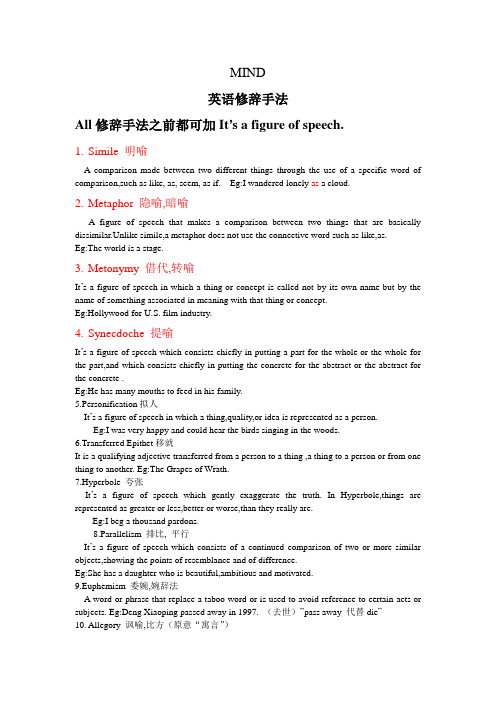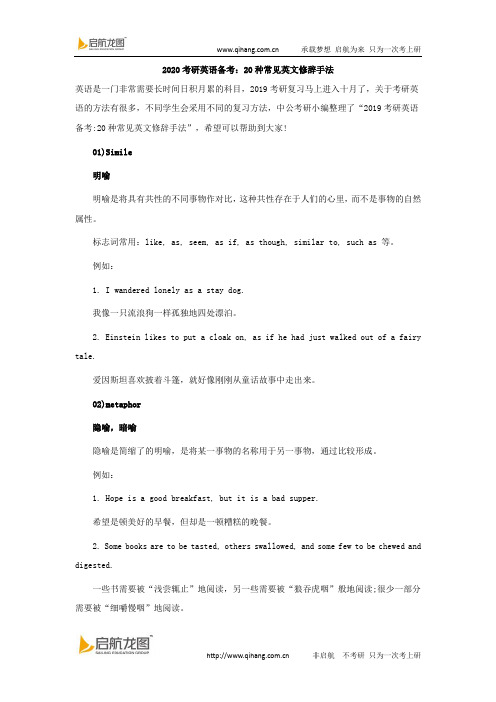20种英语修辞手法整理教学内容
- 格式:docx
- 大小:22.75 KB
- 文档页数:7

英语最全修辞手法英语常用修辞1.Simile 明喻明喻是将具有共性的不同事物作对比.这种共性存在于人们的心里,而不是事物的自然属性。
或者说是以两种具有相同特征的事物和现象进行对比,表明本体和喻体之间的相似关系,两者都在对比中出现。
标志词常用like, as, seem, as if, as though, similar to, such as等. It is a figure of speech which makes a comparison between two unlike elements having at least one quality or characteristic in common. To make the comparison, words like as, as...as, as if and like are used to transfer the quality we associate with one to the other.例如:1>.He was like a cock who thought the sun had risen to hear him crow.2>.I wandered lonely as c cloud.3>.Einstein only had a blanket on, as if he had just walked out of a fairy tale.4>.This elephant is like a snake as anybody can see.这头象和任何人见到的一样像一条蛇。
5>.He looked as if he had just stepped out of my book of fairytales and hadpassed me like a spirit.他看上去好像刚从我的童话故事书中走出来,像幽灵一样从我身旁走过去。

MIND英语修辞手法All修辞手法之前都可加It’s a figure of speech.1.Simile 明喻A comparison made between two different things through the use of a specific word of comparison,such as like, as, seem, as if. Eg:I wandered lonely as a cloud.2.Metaphor 隐喻,暗喻A figure of speech that makes a comparison between two things that are basically dissimilar.Unlike simile,a metaphor does not use the connective word such as like,as.Eg:The world is a stage.3.Metonymy 借代,转喻It’s a figure of speech in which a thing or concept is called not by its own name but by the name of something associated in meaning with that thing or concept.Eg:Hollywood for U.S. film industry.4.Synecdoche 提喻It’s a figure of speech which consists chiefly in putting a part for the whole or the whole for the part,and which consists chiefly in putting the concrete for the abstract or the abstract for the concrete .Eg:He has many mouths to feed in his family.5.Personification拟人It’s a figure of speech in which a thing,quality,or idea is represented as a person.Eg:I was very happy and could hear the birds singing in the woods.6.Transferred Epithet移就It is a qualifying adjective transferred from a person to a thing ,a thing to a person or from one thing to another. Eg:The Grapes of Wrath.7.Hyperbole 夸张It’s a figure of speech which gently exaggerate the truth. In Hyperbole,things are represented as greater or less,better or worse,than they really are.Eg:I beg a thousand pardons.8.Parallelism 排比, 平行It’s a figure of speech which consists of a continued comparison of two or more similar objects,showing the points of resemblance and of difference.Eg:She has a daughter who is beautiful,ambitious and motivated.9.Euphemism 委婉,婉辞法A word or phrase that replace a taboo word or is used to avoid reference to certain acts or subjects. Eg:Deng Xiaoping passed away in 1997. (去世)”pass away 代替die”10.Allegory 讽喻,比方(原意“寓言”)2>.It's time to turn plough into sword.表层含义:是时候把犁变成剑11.Irony 反语It’s a figure of speech in which the words of the speaker or writer seems to mean one thing,but in reality mean just the contrary.Eg:It would be a fine thing indeed not knowing what time it was in the morning.早上没有时间观念还真是一件好事啊(真实含义是应该明确早上的时间观念)12.Pun 双关1>.She is too low for a high praise, too brown for a fair praise and too little for a great praise.2>.An ambassador is an honest man who lies abroad for the good of his country.3>.If we don't hang together, we shall hang separately.13.Parody 仿拟例如:1>.Rome was not built in a day, nor in a year.2>.A friend in need is a friend to be avoided.3>.If you give a girl an inch nowadays she will make address of it.14.Rhetorical question 修辞疑问(反问)它与疑问句的不同在于它并不以得到答复为目的,而是以疑问为手段,取得修辞上的效果,其特点是:肯定问句表示强烈否定,而否定问句表示强烈的肯定.它的答案往往是不言而喻的.例如:1>.How was it possible to walk for an hour through the woods and see nothing worth of note?2>.Shall we allow those untruths to go unanswered?15.Antithesis 对照,对比,对偶这种修辞指将意义完全相反的语句排在一起对比的一种修辞方法.例如:1>.Not that I loved Caeser less but that I loved Romemore.2>.You are staying; I am going.3>.Give me liberty, or give me death.16.Paradox 隽语这是一种貌似矛盾,但包含一定哲理的意味深长的说法,是一种矛盾修辞法..例如:1>.More haste, less speed.欲速则不达2>.The child is the father to the man.(童年时代可决定人之未来)三岁看大,四岁看老。

20种常见的英语修辞手法,恶补考研基础毙考题----
904a7968-6ea3-11ec-b3c0-7cb59b590d7d
20种常见的英语修辞手法,恶补考研基础-毙考题
20种常用英语修辞手段构成研究生入学考试的基础
01simile明喻
比喻是把不同的事物与共性进行比较,共性存在于人们的心中,而不是事物的自然属性。
标志词常用:like,as,seem,asif,asthough,similarto,suchas等。
例如:
1.IwandedLonelyasastaydog。
我像一只流浪狗一样四处游荡。
2.einsteinlikestoputacloakon,asifhehadjustwalkedoutofafairytale.
爱因斯坦喜欢穿斗篷,就好像他刚从童话故事中走出来一样。
02metaphor隐喻,暗喻
隐喻是一种缩短的明喻,它是通过比较将一个事物的名称应用于另一个事物而形成的。
例如:
1.hopeisagoodbreakfast,butitisabadsupper.希望是顿美好的早餐,但却是一顿糟
糕的晚餐。
2.有些书需要翻,有些书需要翻,有些书需要咀嚼和消化。
一些书需要被浅尝辄止地阅读,另一些需要被狼吞虎咽般地阅读;很少一部分需要被
细嚼慢咽地阅读。
转喻
借喻不直接说出所要说的事物,而使用另一个与之相关的事物名称。
1.用容器替换内容物,例如:
1)thekettleboils.水开了。
2) theroomsatsilent。
整个房间都安静地坐着。
2.以资料、工具代替事物的名称,例如:。

2020考研英语备考:20种常见英文修辞手法英语是一门非常需要长时间日积月累的科目,2019考研复习马上进入十月了,关于考研英语的方法有很多,不同学生会采用不同的复习方法,中公考研小编整理了“2019考研英语备考:20种常见英文修辞手法”,希望可以帮助到大家!01)Simile明喻明喻是将具有共性的不同事物作对比,这种共性存在于人们的心里,而不是事物的自然属性。
标志词常用:like, as, seem, as if, as though, similar to, such as 等。
例如:1. I wandered lonely as a stay dog.我像一只流浪狗一样孤独地四处漂泊。
2. Einstein likes to put a cloak on, as if he had just walked out of a fairy tale.爱因斯坦喜欢披着斗篷,就好像刚刚从童话故事中走出来。
02)metaphor隐喻,暗喻隐喻是简缩了的明喻,是将某一事物的名称用于另一事物,通过比较形成。
例如:1. Hope is a good breakfast, but it is a bad supper.希望是顿美好的早餐,但却是一顿糟糕的晚餐。
2. Some books are to be tasted, others swallowed, and some few to be chewed and digested.一些书需要被“浅尝辄止”地阅读,另一些需要被“狼吞虎咽”般地阅读;很少一部分需要被“细嚼慢咽”地阅读。
03)metonymy借喻,转喻借喻不直接说出所要说的事物,而使用另一个与之相关的事物名称。
1. 以容器代替内容,例如:1)The kettle boils.水开了。
2)The room sat silent.全屋人安静地坐着。
2. 以资料、工具代替事物的名称,例如:Lend me your ears, please.请听我说。

英语修辞手法英语中的修辞与汉语的修辞相比,分类细,种类多.下面将英语的修辞简单介绍如下:Simile 明喻明喻是将具有共性的不同事物或现象作对比。
这种共性存在于人们的心里,而不是事物的自然属性.标志词he had just walked out of a fairy tale.Metaphor隐喻,暗喻隐喻是简缩了的明喻, 不是通过比喻词进行,甲乙两事物之间的联系和相似之处是暗含的。
而是直接将甲事物当作乙事物来描写即将某一事物的名称用于另一事物,通过比较形成。
1. German guns and German planes rained down bombs, shells and bullets.德国人的枪炮和飞机将炸弹、炮弹和子弹像暴雨一样倾泻下来。
2. The diamond department was the heart and center of the store.Metonymy 借喻,转喻借喻不直接说出所要说的事物,而使用另一个与之相关的事物名称.I.以容器代替内容1. The kettle boils. 水开了。
2. The room sat silent. 全屋人安静地坐着。
II.以资料.工具代替事物的名称Lend me your ears, please. 请听我说。
III.以作者代替作品a complete Shakespeare莎士比亚全集VI.以具体事物代替抽象概念I had the muscle, and they made money out of it.我有力气,他们就用我的力气赚钱.Synecdoche 提喻又称举隅法,主要特点是用部分代替全体,或用全体代替部分,或特殊代替一般.或以抽象代具体,或以具体代抽象。
men.句中的“the flesh and blood”喻为(巨大的牺牲)2.“tongue”代替抽象的—岁的黑姑娘。
这里的“many eyes”代替了4. There are about 100 (部分代整体)他的厂里约有100名工人。

英文中最常见的20种修辞手法(解释例句)和我们精通的中文一样,英文写作中也存在各式各样的修辞手法。
今天给大家介绍最常见的20种英文修辞手法。
细细体会,争取把他们用到你的作文中:01Simile明喻明喻是将具有共性的不同事物作对比,这种共性存在于人们的心里,而不是事物的自然属性。
标志词常用:like, as, seem, as if, as though, similar to, such as 等。
例如:1. I wandered lonely as a stay dog.我像一只流浪狗一样孤独地四处漂泊。
2. Einstein likes to put a cloak on, as if he had just walked out of a fairy tale.爱因斯坦喜欢披着斗篷,就好像刚刚从童话故事中走出来。
02展开剩余92%metaphor隐喻,暗喻隐喻是简缩了的明喻,是将某一事物的名称用于另一事物,通过比较形成。
例如:1. Hope is a good breakfast, but it is a bad supper.希望是顿美好的早餐,但却是一顿糟糕的晚餐。
2. Some books are to be tasted, others swallowed, and some few to be chewed and digested.03metonymy借喻,转喻借喻不直接说出所要说的事物,而使用另一个与之相关的事物名称.1. 以容器代替内容,例如:1)The kettle boils.水开了。
2)The room sat silent.全屋人安静地坐着。
2. 以资料、工具代替事物的名称,例如:Lend me your ears, please.请听我说。
3. 以作者代替作品,例如:a complete Shakespeare莎士比亚全集4. 以具体事物代替抽象概念,例如:I had the muscle, and they made money out of it.我有力气,他们就用我的力气赚钱。
英语中所有19种修辞手法的全部解释和例句,英语中所有19种修辞手法的全部解释和例句:Simile明喻、Metaphor 隐喻,暗喻、Metonymy 借喻,转喻、Synecdoche 提喻、Synaesthesia 通感,联觉,移觉、Personification 拟人、Hyperbole 夸张、Parallelism 排比, 平行、Euphemism 委婉,婉辞法、Allegory 讽喻,比方、Irony 反语、Pun 双关、Parody 仿拟、Rhetorical question 修辞疑问、Antithesis 对照,对比,对偶、Paradox 隽语、Oxymoron 反意法,逆喻、Climax 渐进法,层进法、Anticlimax 渐降法。
快来学习吧!1.Simile 明喻明喻是将具有共性的不同事物作对比.这种共性存在于人们的心里,而不是事物的自然属性.标志词常用like, as, seem, as if, as though, similar to, such as等.例如:1>.He was like a cock who thought the sun had risen to hear him crow.2>.I wandered lonely as a cloud.3>.Einstein only had a blanket on, as if he had just walked out of a fairy tale.2.Metaphor 隐喻,暗喻隐喻是简缩了的明喻,是将某一事物的名称用于另一事物,通过比较形成.例如:1>.Hope is a good breakfast, but it is a bad supper.2>.Some books are to be tasted, others swallowed, and some few to be chewed and digested.3.Metonymy 借喻,转喻借喻不直接说出所要说的事物,而使用另一个与之相关的事物名称.I.以容器代替内容,例如:1>.The kettle boils. 水开了.2>.The room sat silent. 全屋人安静地坐着.II.以资料.工具代替事物的名称,例如:Lend me your ears, please. 请听我说.III.以作者代替作品,例如:a complete Shakespeare 莎士比亚全集VI.以具体事物代替抽象概念,例如:I had the muscle, and they made money out of it. 我有力气,他们就用我的力气赚钱.4.Synecdoche 提喻提喻用部分代替全体,或用全体代替部分,或特殊代替一般.例如:1>.There are about 100 hands working in his factory.(部分代整体)他的厂里约有100名工人.2>.He is the Newton of this century.(特殊代一般)他是本世纪的牛顿.3>.The fox goes very well with your cap.(整体代部分)这狐皮围脖与你的帽子很相配.5.Synaesthesia 通感,联觉,移觉这种修辞法是以视.听.触.嗅.味等感觉直接描写事物.通感就是把不同感官的感觉沟通起来,借联想引起感觉转移,“以感觉写感觉”。
英语修辞手法英语中的修辞与汉语的修辞相比,分类细,种类多.下面将英语的修辞简单介绍如下:1.Simile 明喻明喻是将具有共性的不同事物作对比.这种共性存在于人们的心里,而不是事物的自然属性.标志词常用like, as, seem, as if, as though, similar to, such as等.例如:1>.He was like a cock who thought the sun had risen to hear him crow.2>.I wandered lonely as a cloud.3>.Einstein only had a blanket on, as if he had just walked out of a fairy tale.2.Metaphor 隐喻,暗喻隐喻是简缩了的明喻,是将某一事物的名称用于另一事物,通过比较形成.例如:1>.Hope is a good breakfast, but it is a bad supper.2>.Some books are to be tasted, others swallowed, and some few to be chewed and digested.3.Metonymy 借喻,转喻借喻不直接说出所要说的事物,而使用另一个与之相关的事物名称.I.以容器代替内容,例如:1>.The kettle boils. 水开了.2>.The room sat silent. 全屋人安静地坐着.II.以资料.工具代替事物的名称,例如:Lend me your ears, please. 请听我说.III.以作者代替作品,例如:a complete Shakespeare莎士比亚全集VI.以具体事物代替抽象概念,例如:I had the muscle, and they made money out of it. 我有力气,他们就用我的力气赚钱.4.Synecdoche 提喻提喻用部分代替全体,或用全体代替部分,或特殊代替一般.例如:1>.There are about 100 hands working in his factory.(部分代整体)他的厂里约有100名工人.2>.He is the Newton of this century.(特殊代一般)他是本世纪的牛顿.3>.The fox goes very well with your cap.(整体代部分)这狐皮围脖与你的帽子很相配.5.Synaesthesia 通感,联觉,移觉这种修辞法是以视.听.触.嗅.味等感觉直接描写事物.通感就是把不同感官的感觉沟通起来,借联想引起感觉转移,“以感觉写感觉”。
1.Simile 明喻明喻是将具有共性的不同事物作对比.这种共性存在于人们的心里,而不是事物的自然属性.标志词常用 like, as, seem, as if, as though, similar to, such as等.例如:1>.He was like a cock who thought the sun had risen to hear him crow.2>.I wandered lonely as a cloud.3>.Einstein only had a blanket on, as if he had just walked out of a fairy tale.2.Metaphor 隐喻,暗喻隐喻是简缩了的明喻,是将某一事物的名称用于另一事物,通过比较形成.例如:1>.Hope is a good breakfast, but it is a bad supper.2>.Some books are to be tasted, others swallowed, and some few to be chewed and digested.3.Metonymy 借喻,转喻借喻不直接说出所要说的事物,而使用另一个与之相关的事物名称.I.以容器代替内容,例如:1>.The kettle boils. 水开了.2>.The room sat silent. 全屋人安静地坐着.II.以资料.工具代替事物的名称,例如:Lend me your ears, please. 请听我说.III.以作者代替作品,例如:a complete Shakespeare 莎士比亚全集VI.以具体事物代替抽象概念,例如:I had the muscle, and they made money out of it. 我有力气,他们就用我的力气赚钱.4.Synecdoche 提喻提喻用部分代替全体,或用全体代替部分,或特殊代替一般.例如:1>.There are about 100 hands working in his factory.(部分代整体)他的厂里约有100名工人.2>.He is the Newton of this century.(特殊代一般)他是本世纪的牛顿.3>.The fox goes very well with your cap.(整体代部分)这狐皮围脖与你的帽子很相配.5.Synaesthesia 通感,联觉,移觉这种修辞法是以视.听.触.嗅.味等感觉直接描写事物.通感就是把不同感官的感觉沟通起来,借联想引起感微风过处送来缕缕清香,仿佛远处高楼上渺茫的歌觉转移,“以感觉?写感觉”。
英语语法:英语的19种修辞手法分析英语中有19种修辞手法分别是:Simile明喻、Metaphor 隐喻,暗喻、Metonymy 借喻,转喻、Synecdoche 提喻、Synaesthesia 通感,联觉,移觉、Personification 拟人、Hyperbole 夸张、Parallelism 排比,平行、Euphemism 委婉,婉辞法、Allegory 讽喻,比方、Irony 反语、Pun 双关、Parody 仿拟、Rhetorical question 修辞疑问、Antithesis 对照,对比,对偶、Paradox 隽语、Oxymoron 反意法,逆喻、Climax 渐进法,层进法、Anticlimax 渐降法。
英语的19种修辞手法具体用法:1.Simile 明喻明喻是将具有共性的不同事物作对比。
这种共性存在于人们的心里,而不是事物的自然属性。
标志词常用 like, as, seem, as if, as though, similar to, such as 等。
例如:1.He was like a cock who thought the sun had risen to hear him crow。
2.I wandered lonely as a cloud。
3.Einstein only had a blanket on, as if he had just walked out ofa fairy tale。
2.Metaphor 隐喻,暗喻隐喻是简缩了的明喻,是将某一事物的名称用于另一事物,通过比较形成。
例如:1.Hope is a good breakfast, but it is a bad supper。
2.Some books are to be tasted, others swallowed, and some few to be chewed and digested。
20种英语修辞手法整理Figure of Speech【整理自PPT】1. Simile 明喻❖是比喻的一种,是对两种具有共同特征的事物或现象进行对比,表明本体和喻体的相似关系,两者都在对比中出现,且常带有比喻词,如:❖ Like/ seem / be something of / as /resemble/ comparable to /similar to / akin to/ be analogous to❖My love is like a red, red rose. (Robert Burns)2. Metaphor 暗喻❖对两种具有共同特征的事物或现象进行对比;所不同的是在形式上,暗喻中本体和喻体之间多通过Be 动词来联系。
省掉比喻词。
❖明喻:Life is like an unexplored river, full of twists and turns, great beauty and dangerous surprises .❖暗喻: Life is an unexplored river, full of twists and turns, great beauty, and dangerous surprises.3. Personification 拟人❖本质上是一种暗喻,其特点是赋予非人类范畴的东西一些人的特征。
❖The forest held its breath, and the trees seemed to listern intently.❖The sun kissed the green fields。
The thirsty desert drank up the water.4. Metonymy 借代/换喻❖是通过借用与某种事物密切相关的东西来表示该事物。
例如用单词word 来表示话语或者消息news,用硬币penny来表示钱 money.❖Word comes that the Chinese government will send a pair of giant pandas to the United States.❖This computer will cost you a pretty penny.5.Antonomasia 换称❖是借代的一种,所不同的是英语换称中所用的专有名词通常源于西方宗教、历史以及文学作品中的专有名词或者形象。
如:❖ Solomon 所罗门------a wise man 聪明人,出自圣经❖ Judas 犹大------ a traitor 叛徒,出自圣经❖ Helen 海伦----------红颜祸水,美女海伦为斯巴达王的王后,因她被帕里斯拐去而引起特洛伊战争。
❖ Venus 维纳斯--------Beauty 美的化身,出自古希腊神话。
❖Reform is a Pandora’s box; opening up the system can lead to a loss of economic and political control.6. Synecdoche 提喻❖是比喻的一种,主要特点是以局部代表全体,或以全体喻指部分,或以抽象代表具体,或以具体代抽象。
与换喻(借代)相比,提喻的本体和喻体之间的关系较单纯。
❖He has many mouths to feed in his family mouth ----people❖They counted fifty sails in the harbour sails ------ships❖He is a valiant heart heart -----man❖提喻的本体与喻体之间的关系是局部—全体,具体—抽象之间的关系,而换喻的本体与喻体之间的关系更为复杂。
7. Analogy 类比❖将两类本质上不同的事物之间的共同点加以比较,在形式上很像比喻,也用比喻词。
常用来阐释复杂的概念。
类比最常见的句型为A is to B asC is to D❖Food is to the body as fuel is to the engine.❖Shoe is to foot as tire is to wheel❖Followers are to a leader as planets are to a sun❖当要解释一个比较抽象的概念时,类比可以很好地帮助你将概念形象化,具体化。
8. Parody 仿拟❖是通过人们熟知的某个谚语、格言、名剧乃至文章体裁适当地改头换面而构成的一种颇为新奇的表达方式。
它既仿照又变化。
❖Hatred begets hatred . 怨怨相报。
--------❖ Tragedy begets tragedy . Lie begets lie.❖No pains, no gains. -----❖ Not root, no fruitp.s. 仿拟是学习英文格言美句的好办法,在仿拟的过程中,还可以对固有的词组和谚语进行创新和改动,以达到修辞的效果。
❖Lady hermits who are down but not out (down and out 穷困潦倒)❖穷困而不潦倒的女隐士们。
9. Anadiplosis 蝉联❖是重复(repetition)一种变形,即在后一句的开头重复前句末尾的词语。
❖They call for you: the general who became a slave; the slave who became a gladiator; the gladiator who defied an Emperor❖They have promised to finish the work and finish it they will.10. Regression 回环❖回环(regression)也是一种重复,它在一个句子或短文中以相反的顺序重复前面出现过的词语。
回环是构成名言警句的常见手段,有很强的生命力。
❖It is better to make friends fast than to make fast friends.❖交友要诚挚,而不是轻率地交朋友。
❖Flowers are lovely; lovely is flower like.❖花儿可爱,可人儿如花。
❖Better to know everything of something than something of everything.❖精通有限的领域,胜过万事都只知道点皮毛。
(培根)11. Irony 反语❖又称为讽刺,通过使用与本义相反的词表示本意,来达到一种嘲弄、赞扬、幽默的效果。
当然,词汇手段只是反语表达的一种。
❖When the doctor came, they said she had died of heart disease----of joy that kills.❖It must be delightful to find oneself in a foreign country without a penny in one’s pocket.❖言语上的反语往往需要配合上下文来理解,它不尽然表达批评或讽刺,有些时候也能表达赞扬和幽默。
12. Paradox 反论❖又称逆论或者是似是而非的隽语,即乍听似乎荒唐而实际上却有道理的某种说法。
❖More haste, less speed.❖What is improbable is extremely probable.❖From disaster fortune comes, in fortune lurks disaster.❖Extremes meet 物极必反❖ A friend to everybody is a friend to nobody 人人友,非真友。
❖Everybody’s business is nobody’s business.p.s. 小提示:反论常常包含有趣的哲学思辨,是构成俗语的重要手段。
圣经中就有许多内涵丰富的反论。
❖Behold, I send you forth as sheep in the midst of wolves: be you therefore wise as serpents, and harmless as doves… 我差你们去,如同羊进入狼群;所以你们要灵巧像蛇,驯良如鸽。
13. Oxymoron 矛盾修辞法❖用两种不调和、甚至截然相反的特征来形容一项事物,在矛盾中寻求哲理,以达到修辞效果。
它是反论的一种浓缩形式。
❖Can enemies become mortal friends ?敌人能成为不共戴天的朋友吗?❖England Harrison worte a book with the title A savage Civilization❖The parental discipline can be described as cruel kindness.小提示:从结构上,可以把矛盾修辞法的两个相反词义关系分位反义关系和准反义关系。
其中准反义关系的为多。
❖反义关系:❖Idiotic wisdom 愚蠢的智慧❖Victorious defeat 胜利的失败❖Crowded solitude 拥挤的独处❖Bitterly happy 苦涩的愉快❖准反义关系❖Cold fire 寒冷的火焰❖Sweet sorrow 甜蜜的悲伤❖Absolutely right 绝对的正确❖ A woman of devastating beauty 倾国倾城的美女14. Paregmenon 同源格❖同源修辞格是一种特殊的重复,即通过使用同一词源的不同词性或不同含义的几个词,取得重复强调或反衬对照的效果。
❖It will destroy the wisdom of the wise❖这会损智者的智慧。
❖He has died a glorious death.❖他光荣就义。
❖Home is home though never so homely.❖华丽乎,简陋乎,家总是家。
❖Money often unmakes the men who make it.❖金钱经常能瓦解那些创造它的人。
❖Man must change in a changing world.❖人必须在变化着的世界里不断变化。
小提示:英语词形的特殊构成(词根、前缀、后缀)使其富于同源词,许多英文的名人隽语都是用同源格构成的。
❖Love sought is good, but given unsought is better. (Shakespeare)❖千寻百觅得来的爱情固然好,佳偶天成则更美妙。